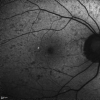Author Notes
Ian M MacDonald, MSc, MD, CM, is Professor Emeritus in the Department of Ophthalmology and Visual Sciences, University of Alberta, and past Chair of the department for 20 years. Prior to becoming Chair in Edmonton, he was a career scientist of the Ontario Ministry of Health at the University of Ottawa. From 2007 to 2008, he served as Branch Chief of Ophthalmic Genetics and Visual Function at the National Eye Institute of the National Institutes of Health. Dr MacDonald trained in genetics as an undergraduate and postgraduate student at McGill University, Montreal. His ophthalmology residency and clinical genetics fellowship training occurred at the University of Ottawa, Queen's University, Kingston, and the Hospital for Sick Children, Toronto.
Dr MacDonald's areas of interest are inherited ocular disorders, in particular maculopathies and choroideremia. In 2009, in recognition of his work in Canada to foster the development of academic ophthalmology, he was elected as a Fellow of the Canadian Academy of Health Sciences. The Canadian College of Medical Geneticists honored him with a Lifetime Achievement Award.
CHM Gene Therapy at University of Alberta website: chmgenetherapy.ca
Acknowledgments
Grant funding from Fighting Blindness Canada is gratefully acknowledged. Past grant funding: CIHR, Alberta Innovates, Choroideremia Research Foundation Inc. Dr Yi Zhai received a fellowship award from the Choroideremia Research Foundation. Dr Manlong Xu received fellowship support from a grateful patient, Pat Krawchuk.
Natural History of the Progression of Choroideremia (NIGHT NCT03359551) and SOLSTICE NCT03584165 was supported by Nightstar Therapeutics and Biogen Study Group.
The choroideremia natural history study (NCT02994368) was supported by funding from 4D Molecular Therapeutics, Inc (Emeryville, CA as sponsor) and Roche Pharma AG.
Author History
Stephanie Hoang, MSc, CGC, CCGC; University of Alberta Hospital (2015-2021)
Stacey Hume, PhD (2015-present)
Ian M MacDonald, MD, CM (2003-present)
Kerry McTaggart, MSc; University of Alberta (2003-2007)
Meira R Meltzer, MA, MS, CGC; National Eye Institute (2007-2010)
Miguel C Seabra, MD, PhD; Imperial College School of Medicine (2003-2021)
Christina Sereda, MSc; University of Alberta (2003-2007)
Nizar Smaoui, MD; GeneDx (2007-2015)
Manlong Xu, MD, PhD (2021-present)
Yi Zhai, MD, PhD (2021-present)





